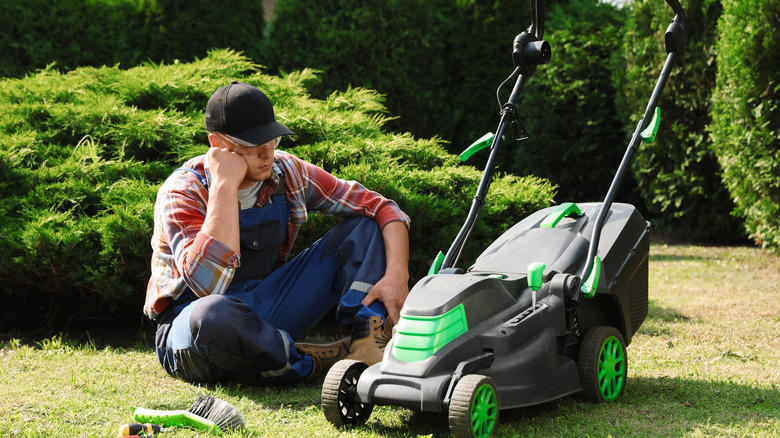The Long-Term Effects Of Using Old Gasoline In Your Lawn Mower
Gasoline has a straightforward purpose, whether it's for vehicles or smaller equipment such as a lawnmower: It makes things go. However, here's one thing many people don't know about this popular fuel source: it deteriorates over time — whether the gas is in a car tank, a can in your garage, or sitting in your lawnmower. In fact, old gas may be the reason your mower won't start after a long winter sitting in the garage. Other problems potentially caused by stale fuel include general performance issues or a mower that sputters at the start and then quickly dies.
While most may take gasoline for granted, it's an unstable energy source — at least scientifically speaking. Since it's a mixture of chemicals, parts of it evaporate at different rates, causing it to not combust as efficiently as time goes on. Oxidation and condensation within your gas tanks can also cause issues for lawnmowers over time and even cause major engine problems if not remedied early on. Luckily, solving an issue caused by bad fuel is often straight forward, as is taking precautions to make sure it's not a problem again in the future.
Why old gas is a problem and what to do about it
While most homeowners often don't notice issues with old gas inside a lawnmower until there's a long break between grass cuttings, typical gasoline starts going bad after just a couple of weeks, and it's advised to use gas within a month or two of pumping it if possible. Because of both oxidation and evaporation, older gasoline is more difficult to ignite and has more gum in it, which can cause issues when it comes to starting and efficiently running the motor. Gummed-up gasoline can lead to clogged lines and filters and even cause permanent damage to your mower's fuel system.
While trouble getting your mower started may be a sign your lawn mower needs to go to a professional to be fixed, there are a couple of steps you can take yourself. You can remove the offending fuel by simply draining out of the tank and replacing it in just a few minutes. Depending on the brand and mower type, you may be able to get rid of the older fuel through the fuel pipe or the filler cap. If you don't have a hose to use as a siphon, a household baster can be used in a pinch.
The hope, of course, is that removing the old fuel from your mower's tank and replacing it with fresh gas will get it humming again. However, if stale gasoline is the culprit of your issues, it's also a good idea to check both the carburetor for clogs and the mower's float bowl for more old gas. If your carburetor is clogged, you'll need to clean it, which is a straightforward and quick job — doing so does requires some special cleaning spray and a few hand tools, however.
How to remedy this issue
Good fuel management is just one of the simple tips to prevent lawn mower damage, but how do you do it? Getting rid of old gasoline before a mower sits for an extended period of time is important, though just letting it run to burn off excess fuel shouldn't be one of the disposal methods considered. In fact, if you choose to simply siphon the gas into a can, that fuel can be used in a vehicle or other gas-powered machine if your mower has a 4-stroke engine (meaning the gas isn't mixed with oil). If you don't want to use that avenue, some cities and towns have disposal options or recycling programs.
There's also an easy way to make sure your gasoline lasts longer. Using a fuel stabilizer slows down degradation, serves a great purpose for your lawn mower, and can keep your gas good for up to two years. Plus, these solutions are cheap; about $5 to $10 for a small bottle of magic. However, it's important to know that a stabilizer is only effective when it's added to new fuel that's about to be put into storage. It can't make bad gas good again. If you go this route, you'll also want to run your mower's motor for a few minutes after adding the stabilizer to your gas tank so it can run through the engine, ensuring your mower will be ready to run smoothly whenever you need it to start next. As you're draining your old gas or protecting a fresh tank, go ahead and change the air filter and check the oil, too.


